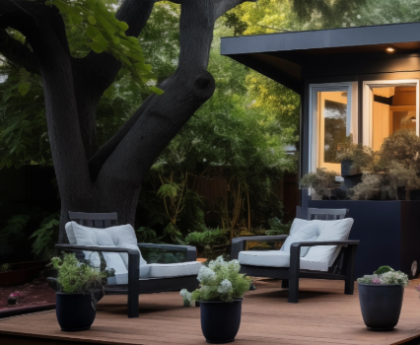
A 2021 California law that allows multiple residences to be built on a single-family lot to increase the state’s housing stock also allows cities to throw notification of the property’s neighbors out the window.
Neighbors of 883 Rorke Way in the Palo Verde neighborhood said this month they were not aware that a vacant residence would be demolished nor that a new two-story home, garage and accessory dwelling unit (ADU) had been granted a permit for the 7,459 square-foot lot.
The new home and ADU is Palo Alto’s first approved housing development under Senate Bill 9, the California Housing Opportunity and More Efficiency (HOME) Act.
SB 9 went into effect on Jan. 1, 2022. It enables all single-family properties, which used to allow one home, to accommodate up to four housing units. It requires only “ministerial approval” without community input for a housing development, provided the applicant wants to build no more than two primary units on the single-family zoned property or wants to subdivide the parcel in a single-family zone into two parcels, or both.
The law thus streamlines the building process by altering municipal review. To qualify, a homeowner must follow a specific list of qualifications that protect historic districts, preserve environmental quality, community appearance and prevent tenant displacement.
In Palo Alto, “single family zones” are categorized as R-1 (and R-1 subdistricts) and R-E districts, said Jonathan Lait, the city’s director of planning and development, in an email.
The streamlining means that certain past protocols won’t be followed when it comes to neighborhood input. Palo Alto used to give notice to neighbors within a certain radius of a property regarding a planned building project. But Lait said that there’s no requirement for public input on an SB 9 application. In fact, the law requires that city staff not make any “subjective” decisions outside of those defined under local and state criteria.
Under SB 9, “ministerial” approval is based on objective, consistently applied criteria outlined in the SB 9 Objective Design Standards for massing, garages, driveways, second stories and landscaping as well as the city’s objective standards relating to setback and height limits.
The 883 Rorke project only required building permits because it conformed to multiple city and state standards, the city said.
But rather than see the benefits of streamlining and objective standards, Palo Alto Mayor Lydia Kou, who opposed SB 9, said the law could have profound effects on the quality of communities over time.
“First and foremost, it is truly undermining the community and democracy. It doesn’t involve any neighborhood input,” she said. “I think the state government needs to stop regurgitating propaganda regarding these unfunded mandates that make it impossible for cities to do right by their people.”
SB 9 was enacted to help create more affordable housing for working families and intergenerational wealth by allowing subdivision of a lot to build a limited number of additional homes, according to a state Senate breakdown of the bill. But Kou said the bill contains nothing that addresses affordability. There are no provisions to require that any of the units be offered at a below-market rate, she said.
“It helps developers gain more money at the expense of the community,” she said, noting the law doesn’t require any additional funding for new parks or amenities.
Kou said she thinks these new developments might cause more on-street parking. It will also inconvenience construction workers, caregivers and others who service the homes and who will also be forced to park further away, she said.
The additional units would also affect the environment, she said, removing carbon sequestration during earthmoving and destroying backyard habitat as lots are further built out, she said.
Proponents of the law, however, say it hasn’t triggered the tidal wave of infill growth that was feared. That’s because SB 9 is more limiting than straight-forward ADU ordinances, according to the University of California Terner Center for Housing Innovation, an equitable-housing think tank.
Lait said the city has only six active SB 9 projects in various stages of review, including building permits filed in 2023: 4025 Orme St., 2430 Bryant St., 2175 Bryant St.; 883 Rorke Way (a building permit filed in 2022, recently issued); 3048 Price Court (a building permit filed in 2022, pending building permit issuance); and 642 Fairmede Ave. (a parcel map filed, but no building permit is filed at this time).
The number of SB 9 applications pales compared to permit requests for accessory dwelling units (ADUs), however. In 2022, Palo Alto had 118 permit requests to build ADUs, according to the state database.
What SB 9 is producing so far
The small SB 9 numbers mirror state applications in general. A University of California Terner Center for Housing Innovation report in January 2023 found that statewide SB 9 has had limited impact thus far. Some of the state’s largest cities reported receiving a handful of applications for either lot splits or new units, while other cities reported none.
A 2021 analysis by the Terner Center estimated that more than 700,000 new homes would be feasible to build if SB 9 passed, but multiple barriers, including high construction costs, would likely make that number far lower.
The center’s study of sample municipal ordinances also found that some local regulations such as a low maximum unit size, height limitations and other design rules might make building under SB 9 infeasible.
While Los Angeles had 211 applications for new units under SB 9 in 2022, other large cities reported very few requests. San Diego reported receiving only seven applications for new SB 9 units in 2022.
“To put these numbers into context, the city of San Diego permitted over 5,000 new homes in all of 2021 and Los Angeles permitted just under 20,000 new homes in 2021,” the report found.
But smaller cities had relatively higher SB 9 applications. Of the 13 municipalities in the study sample, the city of Saratoga reported 15 applications for SB 9 units and 21 applications for lot splits in 2022. In comparison, the city permitted 71 total units of housing in 2021.
The city of Danville received 20 applications for lot splits, but it had no applications for new units, according to the center’s report.
City planners interviewed for the Terner Center study postulated that both Saratoga and Danville are wealthier communities with larger single-family lot sizes. On average-sized lots, most homes are situated in the center of the parcel, making adding another residence geometrically difficult to build.
Saratoga and Danville also have significantly higher home sale prices, making it more likely that splitting a lot will be financially beneficial to the homeowner, the report found.
Homeowners may also be gravitating toward more-flexible accessory dwelling unit ordinances rather than the more restrictive SB 9 rules. While cities such as San Diego and Santa Maria had nearly no SB 9 activity, they had high levels of ADU construction: 871 ADUs and 401 ADUs, respectively, in 2021.
“This contrast is worth pointing out given that ADUs are similar in size and location to new SB 9 units. Planners in cities with high ADU development that we interviewed hypothesized that more prescriptive state ADUs laws are likely pushing homeowners interested in creating new units towards ADUs,” the report stated.
“Recent changes in ADU laws – including laws that limit impact fees, remove owner-occupancy requirements, and allow for larger units – have made it easier to build,” the report found.
SB 9 lacks the same flexibility, according to the report.
“In fact, we found in a previous analysis that some cities are imposing additional requirements on SB 9 projects, including guidelines that are prohibited by state law for ADUs. As such, it may be more attractive for a homeowner to pursue an ADU rather than an SB 9 project,” the report said.




